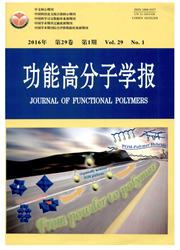

 中文摘要:
中文摘要:
碱性条件下β-环糊精(β-CyD)与二硫化碳反应生成黄原酸盐,随后与α-溴丁酸甲酯反应制得β-环糊精黄原酸酯,并以此为可逆加成-断裂链转移聚合(RAFT)的链转移剂,制备了3种不同接枝链长的共聚物β-环糊精-聚(N,N-二甲基丙烯酰胺)(β-CyD-PDMA)。用核磁共振对β-环糊精黄原酸酯及其接枝共聚物进行了结构表征,考察了β-CyD-PDMA水溶液的黏度、表面张力随接枝链长的变化。通过圆二色谱研究了分子结构的不对称性。使用高分辨透射电镜(HRTEM)、动态光散射(DLS)研究了β-CyD-PDMA在水溶液中的自组装行为。结果表明:β-环糊精上3个6位羟基参与了黄原酸化反应,生成的共聚物为不对称的皇冠状结构;β-CyD-PDMA分子量分布较窄,表现出很好的可控活性聚合特征;接枝共聚物可以进行类胶束聚集,而含有较长PDMA链的共聚物在低浓度下自组装形成直径为280 nm的胶束结构,在高浓度下形成6 nm的新聚集结构。
 英文摘要:
英文摘要:
Xanthogenate was synthesized through reaction of β-cyclodextrin (β-CyD) with carbon disulfide in alkaline solution. It was then reacted with methyl 2-bromobutyrate to produce β-cyclodextrin xanthate as the chain transfer reagent in reversible addition-fragmentation chain transfer polymerization (RAFT). Three graft copolymers β-CyD-PDMA with different chain length were prepared. The structures of β-cyelodextrin xanthate and copolymers were characterized with NMR analysis. The reaction of viscosities, surface tension relation with chain length were studied. The molecule asymmetry was studied by using circular dichroism. The self-assembly behavior of β-CyD-PDMA was studied using high-resolution transmission electron microscopy and dynamic light scattering. The results indicate that three 6-hydroxyl groups of β- cyclodextrin are functionalized, and the copolymer is an asymmetrical crown-like molecule; all the copolymers have narrow molecular weight distribution that is characteristic of controlled polymerization;all copolymers can form micelle, but copolymer with long PDMA chain exist two assemble manners., forming micelle with a diameter of 280 nm at low concentration, while forming a new aggregation with a diameter of 6 nm at high concentration.
 同期刊论文项目
同期刊论文项目
 同项目期刊论文
同项目期刊论文
 期刊信息
期刊信息
